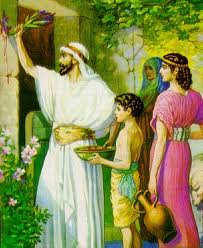
End Of Egyptian Bondage
The observance of the Passover began with the birth of the Hebrew nation. On the last night of their bondage in Egypt, when there appeared no token of deliverance, God commanded them to prepare for an immediate release. He had warned Pharaoh of the final judgment on the Egyptians, and He directed the Hebrews to gather their families within their own dwellings. Having sprinkled the doorposts with the blood of the slain lamb, they were to eat the lamb, roasted, with unleavened bread and bitter herbs. "And thus shall ye eat it," He said, "with your loins girded, your shoes on your feet, and your staff in your hand; and ye shall eat it in haste: it is the Lord's passover." Exodus 12:11. At midnight all the first-born of the Egyptians were slain. Then the king sent to Israel the message, "Rise up, and get you forth from among my people; . . . and go, serve the Lord, as ye have said." Exodus 12:31. The Hebrews went out from Egypt an independent nation. The Lord had commanded that the Passover should be yearly kept. "It shall come to pass," He said, "when your children shall say unto you, What mean ye by this service? that ye shall say, It is the sacrifice of the Lord's passover, who passed over the houses of the children of Israel in Egypt, when He smote the Egyptians." Thus from generation to generation the story of this wonderful deliverance was to be repeated.
The Passover was followed by the seven days' feast of unleavened bread. On the second day of the feast, the first fruits of the year's harvest, a sheaf of barley, was presented before the Lord. All the ceremonies of the feast were types of the work of Christ. The deliverance of Israel from Egypt was an object lesson of redemption, which the Passover was intended to keep in memory. The slain lamb, the unleavened bread, the sheaf of first fruits, represented the Saviour.
With most of the people in the days of Christ, the observance of this feast had degenerated into formalism. But what was its significance to the Son of God!
For the first time the child Jesus looked upon the temple. He saw the white-robed priests performing their solemn ministry. He beheld the bleeding victim upon the altar of sacrifice. With the worshipers He bowed in prayer, while the cloud of incense ascended before God. He witnessed the impressive rites of the paschal service. Day by day He saw their meaning more clearly. Every act seemed to be bound up with His own life. New impulses were awakening within Him. Silent and absorbed, He seemed to be studying out a great problem. The mystery of His mission was opening to the Saviour.
DA 76-78